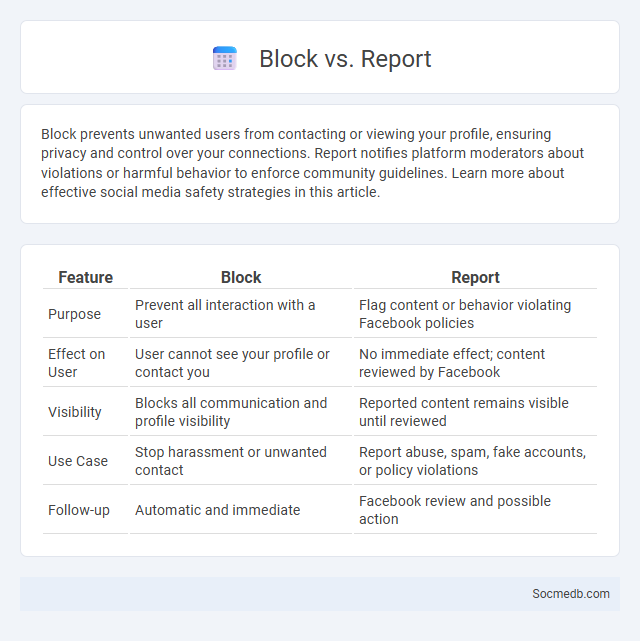
Photo illustration: Block vs Report
Block prevents unwanted users from contacting or viewing your profile, ensuring privacy and control over your connections. Report notifies platform moderators about violations or harmful behavior to enforce community guidelines. Learn more about effective social media safety strategies in this article.
Table of Comparison
| Feature | Block | Report |
|---|---|---|
| Purpose | Prevent all interaction with a user | Flag content or behavior violating Facebook policies |
| Effect on User | User cannot see your profile or contact you | No immediate effect; content reviewed by Facebook |
| Visibility | Blocks all communication and profile visibility | Reported content remains visible until reviewed |
| Use Case | Stop harassment or unwanted contact | Report abuse, spam, fake accounts, or policy violations |
| Follow-up | Automatic and immediate | Facebook review and possible action |
Introduction to Block vs Report vs Block
When managing your social media interactions, understanding the difference between block, report, and block vs. report is crucial for maintaining a safe online environment. Blocking prevents specific users from contacting or viewing your profile, while reporting flags inappropriate behavior or content for platform review and potential action. Using these tools effectively empowers you to control your social media experience and protect your digital privacy.
Understanding the "Block" Feature
The "Block" feature on social media platforms allows You to prevent specific users from interacting with Your content, enhancing privacy and control over Your online experience. When You block someone, they are typically unable to view Your profile, send messages, tag You, or follow Your updates. Understanding how to effectively use this tool helps maintain a safe and enjoyable digital environment.
Exploring the "Report" Function
The "Report" function on social media platforms enables users to flag inappropriate content, harassment, or violations of community guidelines, enhancing overall user safety. This feature directs reported content to platform moderators or automated systems for review and potential removal. Effective use of the report function helps maintain a respectful online environment and reduces the spread of harmful or misleading information.
Key Differences Between Block and Report
Blocking on social media prevents a specific user from viewing your profile, sending messages, or interacting with your content, providing privacy and control over unwanted connections. Reporting involves flagging content or accounts to platform moderators for violating community guidelines, which can result in removal or account suspension after review. While blocking is a personal action to avoid direct contact, reporting contributes to platform safety by addressing harmful or inappropriate behavior.
When to Use Block vs Report
You should use the block feature on social media when you want to prevent specific users from contacting you, viewing your content, or interacting with your profile permanently. The report option is appropriate for flagging abusive, harmful, or spam content that violates platform guidelines and requires review by moderators. Choosing between block and report ensures your online safety while helping maintain a positive community environment.
Platform-Specific Variations
Social media platforms exhibit unique user demographics, content formats, and engagement patterns that influence how you tailor your marketing strategies. Instagram prioritizes visually appealing images and short videos, making it ideal for brands targeting younger audiences, while LinkedIn focuses on professional networking and long-form content. Understanding these platform-specific variations enhances content relevance and boosts user interaction across diverse social media channels.
Impact of Blocking a User
Blocking a user on social media restricts their ability to see your profile, comment on your posts, or send messages, effectively protecting your privacy and reducing online harassment. This action can significantly improve mental well-being by eliminating negative interactions and preventing cyberbullying. Furthermore, it enhances your control over your digital environment, enabling a safer and more personalized social media experience.
What Happens After Reporting?
After reporting inappropriate content on social media, your report is reviewed by the platform's moderation team using a combination of automated tools and human evaluators. The content may be removed, restricted, or left unchanged depending on the severity and community guidelines violations. You will typically receive a notification about the outcome, helping you understand the platform's enforcement actions and keeping you informed about your report's status.
Privacy and Safety Considerations
Social media platforms implement advanced encryption and multifactor authentication to protect user data and prevent unauthorized access. Privacy settings allow users to control the visibility of their personal information, reducing the risk of identity theft and cyberbullying. Safety features like content moderation and reporting tools help create a secure online environment while complying with regulations such as GDPR and CCPA.
Choosing the Right Action for Online Safety
Selecting the right action for online safety involves using strong, unique passwords and enabling two-factor authentication on social media platforms like Facebook, Instagram, and Twitter. Regularly updating privacy settings to limit data sharing and reviewing friend lists help protect personal information from cyber threats. Staying informed about platform-specific security features reduces the risk of identity theft and unauthorized access.
 socmedb.com
socmedb.com